
Aleutian aircraft of WWII
Last updated: July 24, 2020

"...we must guard against the acquisition of unwarranted influence, whether sought or unsought, by the military-industrial complex. The potential for the disastrous rise of misplaced power exists and will persist. We must never let the weight of this combination endanger our liberties or democratic processes... Only an alert and knowledgeable citizenry can compel the proper meshing of the huge industrial and military machinery of defense with our peaceful methods and goals so that security and liberty may prosper together." US President Dwight D. Eisenhower, farewell address, January 17, 1961.
Recent additions:
B-26 40-1408 Thornbrough June 4, 1942
P-38 Lightnings of the Aleutian Islands (summary web page)
(Click on thumbnails to scroll down)
Dutch Harbor Imperial Japanese attack June 3-4, 1942
 |
 |
 |
 |
 |
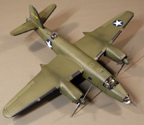 |
Kiska and Attu Allied counter-attack June 11, 1942 - August 15, 1943
 |
 |
 |
 |
 |
 |
 |
 |
 |
 |
 |
 |
 |
 |
 |
 |
 |
 |
Attu battle May - June 1943
 |
 |
 |
Attu - Kuriles American offensive July 10, 1943 - May 1945
 |
 |
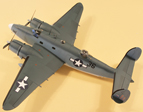 |
 |
 |
B-26 Thornbrough, Cold Bay Ryujo attacker, June 4, 1942


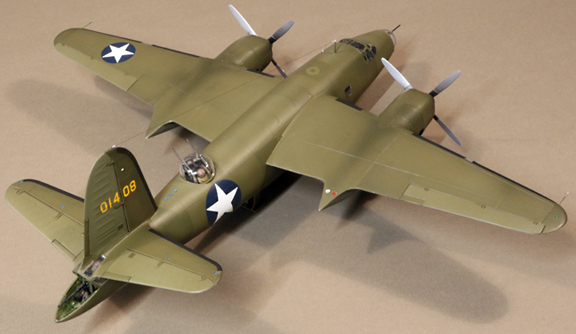
Aircraft: B-26 Marauder, serial number 40-1408, 28th Bombardment Group, 73rd Bombardment Squadron, United States Army Air Force, Cold Bay, lost June 4, 1942, pilot Cpt. George W. Thornbrough.
[June 4, 1942] "Captains George Thornbrough and Harry S. Taylor... continued on.. Their perseverence was rewarded. Ahead Japanese ships loomed out of the mist. ... [Thornbrough] headed his bomber in a high speed dive towords the Ryujo... Commander Okumiya and the others aboard looked in wonder as the 'brave American pilot' bore down on their carrier. They watched as the torpedo separated from the bomber and came hurtling at the carrier only to flash across the deck and into the ocean on the opposite side without exploding. On arrival back at Cold Bay [Thornbrough]... ordered his bomber loaded with 500 pound armor piercing bombs... headed out again to try to find the Japanese. Later that night the airfield control tower at Cold Bay heard him report that he was 'over the station with 9,000 feet on top'. Efforts to assist him failed...' (Cloe 1992)
Reference: Cloe (1992).
Kit: Monogram #5501 (1978) 1/48.
Accessories/modifications: Lone Star Models shortwing B-26 conversion resin, Engines and Things resin Pratt & Whitney R-2800-5 18 cyl. engines (#48-155), Master brass US shark-fin pitots x2 (AM48156), Master brass Browning M2 .50 caliber gun barrels x4 (AM48029), True Details resin USN Mk 13 aerial torpedo (TD48506), Archer Fine Transfers aircraft access panels (AR88167), Eduard canopy masks (EDEX105).
Paint: Tamiya acrylic, Alclad Aluminum, weathering by oil wash and silver Prismacolor pencil, Testor's Dullcoat from spray can.
Decals: Eagle Strike yellow serial numbers (48049), other markings painted with masks.
Issues: Difficult.





Aircraft: Curtiss P-40E Warhawk, serial number unknown, Eleventh Fighter Squadron, 343rd Fighter Group, United States Army Air Force, Umnak Island, June 1942, pilot unknown - initials: 'J.W.E.'
[June 3, 1942] "The radio operator at Dutch Harbour tapped out a hurried message, 'about to be bombed.' ... To the east, Major Chennault's P-40 pilots went about their morning business, unaware of what was taking place at Dutch Harbour. The jerry-rigged communications system that had been hastily installed between the Navy base and the forward army air field had failed.' (Cloe 1992)
Reference: Photos (above).
Kit: Hasegawa #08879 1/32.
Accessories/modifications: Exhaust cold air shields scratchbuilt with styrene card and brass shim, Quickboost resin exhausts QB32159, Eduard Brassin resin tires ED632080.
Paint: Tamiya acrylic, weathering by oil wash and silver Prismacolor pencil, Testor's Dullcoat from spray can.
Decals: Techmod numbers, all other markings painted with masks (Montex MXK32312).
Issues: none.
A6M2 type O model 21 Zero-sen ('Zeke')


Aircraft: Mitsubishi A6M2 type 21 Zero-sen (Allied code name 'Zeke'), aircraft "DII-105" of No. 6 Koku Sentai, Imperial Japanese Navy, aircraft carrier Junyo ('[Peregrine] Falcon'), attack on Dutch Harbor, Unalaska Island, June 3-4, 1942.
'... the Catalina hit the waters to the south, off Egg Island, in flames. Several survivors crawled into a raft, only to be strafed by the Zero pilots. All died.' (Cloe 1992)
Reference: Koku-Fan #42 Japanese and Imperial Army and Navy Colours and Markings. p. 4.
Kit: Hasegawa #09143 1/48.
Accessories/modifications: Ultracast seat (#48185), Quickboost resin pitot tube (48312), exhausts drilled out.
Paint: Tamiya acrylic, Alclad Aluminum II, weathering by oil wash and silver and terra cotta Prismacolor pencil, Testor's Dullcoat from spray can.
Decals: tail code, 'no step' stencil and propellor warning stripes from the kit decals, all other markings painted with masks.
Issues: Colour of rear deck inside cockpit - controversial as to what it was. Possibly 'black' although this would cause intolerable cockpit heating in tropical environments; alternatively, could have been exterior colour, but this has been suggested to be unlikely due to the reflected glare issue on gray-green aircraft. Good reference photos lacking.
D3A type 99 Kanjo-bakugekiki ('Val')



Aircraft: Aichi D3A type 99 (Allied code name 'Val'), aircraft "DII-224"of No. 6 Koku Sentai, Imperial Japanese Navy, aircraft carrier Junyo ('[Peregrine] Falcon'), attack on Dutch Harbor, Unalaska Island, June 3-4, 1942.
'Another Val pilot... dropped his bombs on the Bureau of Indian Affairs Hospital at Unalaska. The nurses' wing was demolished... [later] The pilots of the two damaged Vals, with all hope lost of reaching the Junyo, shouted 'Banzai to the Emperor' as they headed for the cold waters of the North Pacific below.' (Cloe 1992)
Reference: Operations in the North Pacific. Model Art Magazine No. 27
Kit: Hasegawa #09055 1/48.
Accessories/modifications: Vector resin 'Lewis' gun (VDS48-016), Eduard IJN seatbelts (49004), exhausts drilled out.
Paint: Tamiya acrylic, Alclad Aluminum II, weathering by oil wash and silver and terra cotta Prismacolor pencil, Testor's Dullcoat from spray can.
Decals: tail code and propellor warning stripes from the kit decals, all other markings painted with masks.
Issues: none.


Aircraft: Nakajima B5N2 type 97 (Allied code name 'Kate') of No. 4 Koku Sentai, Imperial Japanese Navy, Petty Officer 2nd class Asao Kawahara, aircraft "DI-308", aircraft carrier Ryujo ('Prancing Dragon'), attack on Dutch Harbor, Unalaska Island, June 3-4, 1942.
'The next flight of Kates was sighted four minutes after the first. Ten bombs were dropped. One made a direct hit on a Navy 20mm AA gun position, killing Lieutenant Kenneth Greiner and three of the gun's crew.' (Cloe 1992)
Reference: From the kit.
Kit: Hasegawa #09844 1/48.
Accessories/modifications: Ultracast seat (#48185), styrene spars added internally to stiffen wings, exhausts drilled out.
Paint: Tamiya acrylic, Alclad Aluminum II, weathering by oil wash and silver and terra cotta Prismacolor pencil, Testor's Dullcoat from spray can.
Decals: tail code from the kit decals, all other markings painted with masks.
Issues: none.
A6M2 type 21 Zero-sen ('Zeke') KOGA
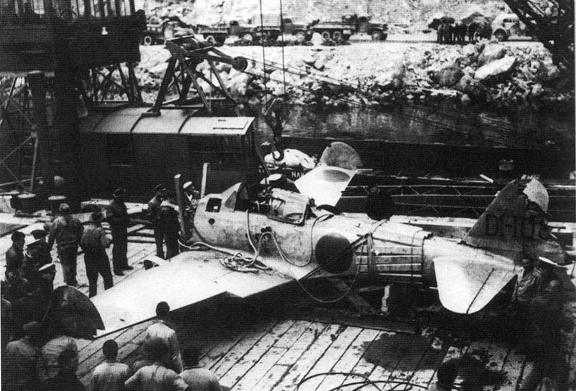
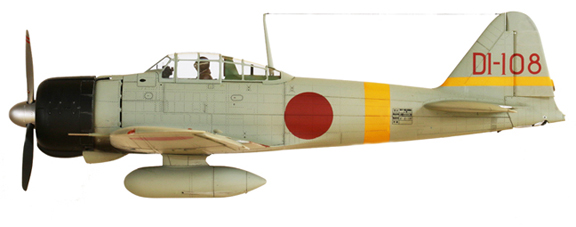


Aircraft: Mitsubishi A6M2 type 0 model 21 Zero-sen (Allied code name 'Zeke'), aircraft "DI-108", pilot Petty Officer Tadayoshi Koga, Imperial Japanese Navy, aircraft carrier Ryujo ('Prancing Dragon'), attack on Dutch Harbor, Unalaska Island, June 3-4, 1942.
''...rounds had punctured the upper and lower surfaces of the Zero. One passed through the fuselage tail cone, tail wheel bracket and solid rubber tire. Another hit the plywood belly tank from below. The round that did the [crucial] damage had gone through the underside of the cowling near the oil cooler, severing the oil return line.' (Cloe 1992)
References: Cloe, J.H. 1992. The Aleutian Warriors: A History of the 11th Air Force & Fleet Air Wing 4. Missoula, Montana: Pictorial Histories Publishing Co. and Anchorage Chapter, Air Force Association.
Kit: Tamiya #60317 1/32.
Accessories/modifications: antenna cable made from Uschi standard rigging line (USH4005).
Paint: Tamiya spray lacquer AS29, Tamiya acrylics, Alclad Aluminum II, weathering by oil wash and silver Prismacolor pencil, Testor's Dullcoat from spray can.
Decals: tail code, stencils and propellor warning stripes from the kit decals, tail code and data stencil from Yellowhammer YHD32014, all other markings painted with masks.


Aircraft: Consolidated PBY-5A Catalina, serial number unknown, United States Navy, Adak Island, 1942 - possibly shown flying by Segula Island.
Reference: photo (above), John Huston's film "Report from the Aleutians"
Kit: Revell/Promodeller 1/48 #5617
Accessories/modifications: none.
Paint: Tamiya acrylic, weathering by oil wash and silver Prismacolor pencil, Testor's Dullcoat from spray can.
Decals: Yellow Wings YW48048 - US National insignia PT-3 May 1942-June 1943, Techmod numbers.
Issues: kit tail shape is allegedly a bit off but I'm not too concerned.
P-40E Warhawk 'Aleutian Tiger'


Aircraft: Curtiss P-40E Warhawk, serial number unknown - possibly 40-596, Eleventh Fighter Squadron, 343rd Fighter Group, United States Army Air Force, Umnak Island, summer 1942, pilot unknown.
Reference: Cloe, J.H. 1992. The Aleutian Warriors: A History of the 11th Air Force & Fleet Air Wing 4. Missoula, Montana: Pictorial Histories Publishing Co. and Anchorage Chapter, Air Force Association.
Kit: Hasegawa #09789 1/48.
Accessories/modifications: Eduard cockpit interior, exhausts drilled out.
Paint: Tamiya acrylic, weathering by oil wash and silver Prismacolor pencil, Testor's Dullcoat from spray can.
Decals: from the kit.
Issues: tiger nose art decal is slightly different from original (?), this particular aircraft is more than a little 'overexposed' as a modeling subject.


Aircraft: Lockheed P-38E Lightning 41-2005 'yellow 86', Lt. Thomas Archer, United States Army Air Force, Adak 1942.
"On December 25 [1942] the engines quit... on takeoff from Adak. The fighter crashed into a parked B-24 from the 21st bombardment squadron."
References: Cloe, J.H. 1992. The Aleutian Warriors: A History of the 11th Air Force & Fleet Air Wing 4. Missoula, Montana: Pictorial Histories Publishing Co. and Anchorage Chapter, Air Force Association, John' Huston's film "Report from the Aleutians"
Kit: Academy #12208 1/48.
Accessories/modifications: None.
Paint: Tamiya acrylic, weathering by oil wash and silver Prismacolor pencil, Testor's Dullcoat from spray can.
Decals: from the kit, Techmod numbers.
Issues: the Academy kit's boom radiator cowlings are the wrong shape for a P-38EFG (they are P-38J-L cowlings), kit decals poor, overall coat of Future for decal setting resulted in glossy finish that couldn't be overcome by Testor's Dullcoat, serial number needs to be corrected to 12005, or possibly 12004, 'U.S. ARMY' mark needs to be added to underwings.

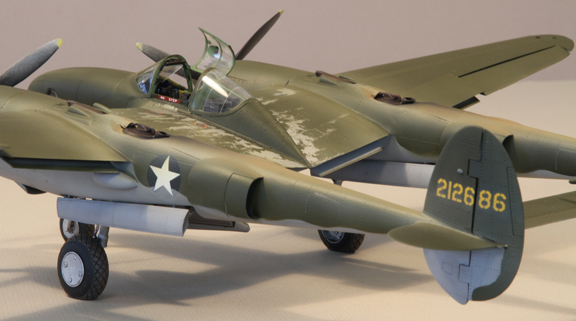
Aircraft: Lockheed F-5A-1-LO Lightning, serial number 42-12686, United States Army Air Force, Adak Island, winter 1942-43, pilot unknown.
References: from the photograph (above).
Kit: Trumpeter #2227, 1/32.
Accessories/modifications: This is a conversion from Trumpeter's excellent P-38L-1-LO kit to a F-5A-1-LO, a much earlier version of the Lightning, similar to a late P-38E or early P-38F. Added semicircular intercooler vents in upper wing tips and round intakes at wing leading edge (drilled out). Cut, modified, and drilled out kit turbo supercharger to fit P-38 EFG / F-5A style cowling. Modified kit turbocharger air supply scoop to P-38 EFG style (shorter, non-laminar flow shape). Drilled out and placed small tubular air ducts on forward sides of resin engine cowlings. Deleted and filled in leading edge wing lights. Deleted, filled and smoothed over upper wing tip fuel ports. Added retractable under wing lights (drilled out, scratch built, Alclad chrome, filled with ‘clear’, finished with Future). Removed underwing power assist bulges, filled and smoothed out. Removed gun camera from port drop tank boom, filled and smoothed out. Removed longitudinal frame from rear canopy, sanded and buffed out, Futured, then added two latitudinal scratches. Modified kit top canopy to side opening hinge-type. Made bulletproof glass (from CD case clear styrene), buffed and Futured, inserted under Cutting Edge windscreen. Four aluminum and steel spars for wing stiffness. Lead weight in engine cowlings and camera nose. Cutting Edge P-38 EFG conversion resin - windscreen, radiators, engine cowlings, turbo supercharger shrouds). Cutting Edge F-5A conversion resin – camera nose. Cutting Edge and Jerry Rutman P-38 EFG cockpit resin. Jerry Rutman props. Scale Aircraft Conversions white metal landing gear. Contact Resine tires. Thanks to John Clements for tips on details.
Paint: Tamiya acrylic, Alclad Aluminum II, weathering by oil wash and silver Prismacolor pencil, Testor's Dullcoat from spray can.
Decals: National marks with Yellow-wings YW48048 - U.S. National Insignia PT-3 May 1942-June 1943, Techmod yellow serial number.
Issues: Expensive. The Cutting Edge resin is good, but not perfect (boom radiators are too short by c. 6 scale inches) and considerable scratchbuilding and elements of the Jerry Rutman resin kits were required to make the P-38L into a facilmile of a F-5A. Forgot to pull masks off mirrors on insides of engine cowlings before photographing.


Aircraft: Consolidated B-24D-15-CO Liberator 41-23973, United States Army Air Force, Adak Island, 1942-1943 (pictured above flying west by Segula Island just east of Kiska)
Reference: Dorr, R.F. 1999. B-24 Liberator Units of the Pacific War. Osprey Publishing, p. 17.
Kit: Revell/Promodeler #85-5604 1/48.
Accessories/modifications: Squadron vacuform canopies and True Details resin tires. Styrene card used to build roof of bomb bay.
Paint: Tamiya acrylic, weathering by oil wash and silver Prismacolor pencil, Testor's Dullcoat from spray can.
Decals: Iliad #4813 ASW B-24 Liberators, Techmod numbers.
Issues: props - photos of Aleutian B-24Ds all show elliptical shaped propellor blades, not the paddle-shaped blades that come with the old Monogram kit. Need to add 'U.S. ARMY' marks and Yagi radar antennas under the wings, I did not attempt the complex antenna over the rear fuselage. This aircraft may have displayed a group badge above/behind the big number 22. Panel differential fading is a bit extreme on this model.
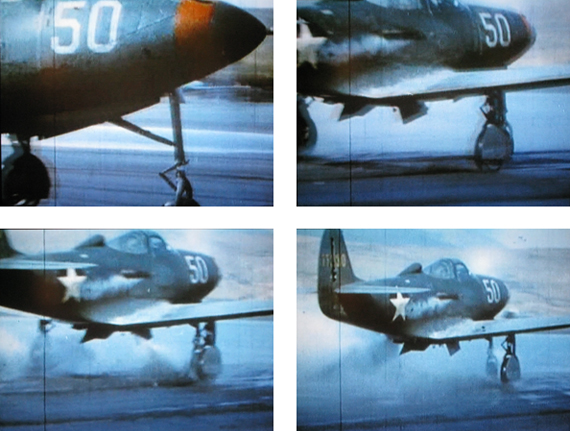

Aircraft: Bell P-39F-1BE Airacobra 41-7130 'white 50', 57th Fighter Squadron, United States Army Air Force, Adak Island, late summer 1942, pilot unknown
Reference: John' Huston's film "Report from the Aleutians".
Kit: Hasegawa #09092 1/48.
Accessories/modifications: Quickboost resin engine, Ultracast seat with seatbelts, replacement short 37 mm gun barrel without blast tube fashioned from styrene rod.
Paint: Tamiya acrylic, Alclad Aluminum II, weathering by oil wash and silver Prismacolor pencil, Testor's Dullcoat from spray can.
Decals: from the kit, Techmod numbers.
Issues: '50' decal is slightly different shape from original, pitot tube broken off port wing.


Aircraft: North American B-25C Mitchell 41-29680, 77th Bomb Group, 'Slug', 'yellow 80', 'Tough luck pal, I have to kill you!' (nose art in Japanese characters), United States Army Air Force, Adak Island, autumn 1942, pilot unknown.
Reference: Cloe, J.H. 1992. The Aleutian Warriors: A History of the 11th Air Force & Fleet Air Wing 4. Missoula, Montana: Pictorial Histories Publishing Co. and Anchorage Chapter, Air Force Association.
Kit: Accurate Miniatures #0030, 1/48.
Accessories/modifications: Eduard etched brass engine and cockpit detail, Scale Aircraft Conversions landing gear, True Details wheels&tires, scratch built nose radar antenna, cowlings opened 2 mm, astrodome height sanded down by about 40%, antenna masts fabricated from styrene card.
Paint: Tamiya acrylic, Alclad Aluminum II, weathering by oil wash and silver Prismacolor pencil, Testor's Dullcoat from spray can.
Decals: Yellow-wings YW48048 - U.S. National Insignia PT-3 May 1942-June 1943, Techmod numbers. 77th Bomb Group emblem and nose and cowl lettering by ILJ (click to download).
Issues: Serial number of this aircraft is unclear - research needed. Nose yaghi radar antenna mast a bit long. Nose art in slightly different orientation from original. Unclear whether this aircraft had field modified tail gun position - some contemporary aircraft did, others did not.


Aircraft: Lockheed PV-1 Ventura 'X-6' of VB-136, Lt. R.R. Lawson, United States Navy, Adak Island, 1943
Reference: Scrivner, C.L. and Scarborough, W.E. 1981. PV-1 Ventura in Action. Squadron/Signal Publications, Carrollton, Texas.
Kit: Fonderie Miniatures #FM6040 1/48
Accessories/modifications: Quickboost gun barrels. Side openings on nose cut out and filled with windows made from bits of transparent CD case.
Paint: Tamiya acrylic, Tamiya fine surface primer from spray can, weathering by oil wash and silver Prismacolor pencil, Testor's Dullcoat from spray can.
Decals: Propagteam 00448 - US. National Insignia pre and early war styles, Techmod numbers.
Issues: this is a very difficult kit to construct, I did not attempt the complex antenna over the fuselage.


Aircraft: North American B-25G Mitchell 42-64754 (possibly a C converted to a G), 77th Bomb Group, United States Army Air Force, Adak Island, July 1943, pilot unknown.
Reference: Cloe, J.H. 1992. The Aleutian Warriors: A History of the 11th Air Force & Fleet Air Wing 4. Missoula, Montana: Pictorial Histories Publishing Co. and Anchorage Chapter, Air Force Association.
Kit: Accurate Miniatures #3432, 1/48.
Accessories/modifications: Eduard etched brass engine and cockpit detail, Scale Aircraft Conversions landing gear, True Details wheels&tires, cowlings opened 2 mm, astrodome height sanded down by about 40%, antenna masts fabricated from styrene card.
Paint: Tamiya acrylic, Alclad Aluminum II, weathering by oil wash and silver Prismacolor pencil, Testor's Dullcoat from spray can.
Decals: from the kit, Techmod numbers.
Issues: Yellow number on the forward fuselage? Another photo taken at Elmendorf shows a B-25G with the large yellow 54 on the side of the fuslage - presumably of this aircraft. Kit armored panel beside cockpit is of exaggerated thickness.


Aircraft: Curtiss P-40K-1-CU Warhawk 42-45951, [LZ] - F, 111 Squadron, Royal Canadian Air Force, Adak Island, September 1942, pilot unknown. One of about ten USAAF P-40K aircraft loaned to the RCAF for Aleutian forward operations during Autumn 1942 - summer 1943.
References: from the photograph (above).
Kit: Hasegawa #09753, 1/48.
Accessories/modifications: Ultracast seat, wheels and exhausts. Canvas wheel-well liner made with masking tape.
Paint: Tamiya acrylic, Alclad Aluminum II, weathering by oil wash and silver Prismacolor pencil, Testor's Dullcoat from spray can.
Decals: National marks with Modeldecal 'A' roundels, [LZ] - F with paint, Techmod yellow serial number.
Issues: Quality of reference photo 'dodgey', green/earth camouflage is speculative (likely possibility that it was uniform olive drab), spinner colour is speculative, possibly was white, yellow or gray, and when did they stop painting US ARMY on P-40K series aircraft? (note the light tan/sand shade of 'earth' - colour photos of Aleutian P-40s show this).
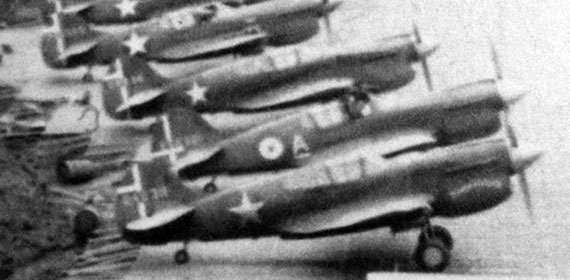
Aircraft: P-40K, serial number 42-45951, gray 'A', 111 Squadron, Royal Canadian Air Force, Amchitka Island, April 1943, pilot unknown. 'Damaged the starboard wing tip after taxiing into parked P-40E '610', at Umnak on 1 September 1942. The aircraft was repaired. '
References: from the photograph (above).
Kit: Hasegawa #08188, 1/32.
Accessories/modifications: Eduard seatbelts, external gunsight replaced with steel wire, fragile tail wheel support replaced with copper tubing and brass rod.
Paint: Tamiya acrylic, Alclad Aluminum II, weathering by oil wash and silver Prismacolor pencil, Testor's Dullcoat from spray can.
Decals: National marks with Modeldecal MD102 'large type 'A' roundels, 'A' with paint, Techmod yellow serial number.
Issues: quality of reference photo is poor, green/earth camouflage is speculative (remote possibility that it was uniform olive drab), spinner colour is speculative (possible was gray), tires probably of block tread type, (note the light tan/sand shade of 'earth' - colour photos of Aleutian P-40s show this).



Aircraft: Curtiss P-40E Warhawk, serial number probably 40-610, Eleventh Fighter Squadron, 343rd Fighter Group, United States Army Air Force, Adak Island, summer 1943, pilot unknown
Reference: from the Life photograph (above).
Kit: Hasegawa #08079 1/32.
Accessories/modifications: Eduard seatbelts, exhausts drilled out, exhaust heat shield fabricated from styrene card, gunsight from music wire.
Paint: Tamiya acrylic, Alclad Aluminum II, weathering by oil wash and silver Prismacolor pencil, Testor's Dullcoat from spray can.
Decals: National marks from the kit, with 1943 bars added with paint, Tiger head with paint and custom decal by ILJ, Techmod yellow numbers, Barracudacals (BC32006) 'US ARMY'.
Issues: Tiger noseart is a bit off. 'Julia' is speculative. This aircraft would certainly have had block tread tires to cope with the slippery Adak airstrip.


Aircraft: Douglas A-24B (Dauntless), serial number 42-54298, 407th Bombardment Group, United States Army Air Force, Amchitka Island, summer 1943, pilot unknown.
Reference: from the photograph (above).
Kit: Italeri #2673 (Accurate Miniatures) 1/48.
Accessories/modifications: Ultracast seats (#48054), exhausts drilled out, kit 'solid rubber' tail wheel cut off and replaced with 'pneumatic' tail wheel assembly from an AMT P-40 kit, RDF loop antenna from a Hasegawa P-40 kit added, scratchbuilt pilot's armor glass and compass added.
Paint: Tamiya acrylic, Alclad Aluminum II, weathering by oil wash and silver Prismacolor pencil, Testor's Dullcoat from spray can.
Decals: From the kit with 1943 national mark red bars distressed with paint, 'Bar Fly' painted over in yellow.
Issues: The Italeri kit does not include an appropriate tail wheel for an A-24. Unclear whether aircraft 42-54298 actually flew in the Aleutians, although its unit certainly did. These aircraft would have had block tread tires to cope with the slippery Aleutian airstrips. Unclear from photographs or other information whether these aircraft were radar equipped.




Aircraft: Curtiss P-40K-1-CU Warhawk 42-9835 (?), 343rd Fighter Group, 18th Fighter Squadron, Flight Officer Joseph Levy, Amchitka Island - crashed while attacking Kiska, July 24, 1943.
References: Painting by Ogden Pleissner (Amchitka, 1943). Otherwise sparse; supposedly, FO Levy was at the controls of 42-9835 when it had an 'accident', June 26, 1943, and this ac was condemned (i.e., written off as a loss) at Elmendorf the next day - however, if the records got the month wrong, these accounts could correspond to the loss of the ac at Kiska on July 26, 1943 (July 25 on Japanese time used by the occupiers of Kiska, see plaque inscription).
Kit: Hasegawa #09753, 1/48.
Accessories/modifications: Ultracast seat, wheels and exhausts. Canvas wheel-well liner made with masking tape.
Paint: Tamiya acrylic, Alclad Aluminum II, weathering by oil wash and silver Prismacolor pencil, Testor's Dullcoat from spray can.
Decals: National marks from SuperScale 48-888 (distressed) with paint, white Aleutian tail codes with paint, Techmod yellow serial number.
Issues: Unclear whether Levy was flying 42-9835 when he was lost - needs further research. I have not been able to find the MACR.
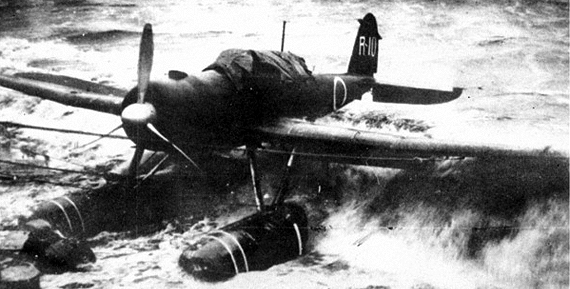

Aircraft: Aichi E13A1a Sui-Tei (Allied code name 'Jake'), 'R-10", No. 5 Kokutai, Imperial Japanese Navy, Kiska Island, autumn 1942 - winter 1942-43, pilot unknown.
References: Imperial Japanese Navy Reconnaissance Seaplanes. Famous Airplanes of the World #47, Bunrindo Publishing, July 1994.
Kit: Nichimo #4803 1/48.
Accessories/modifications: Lone Star Models cockpit and fuselage resin set (LSM 0324), Engines and Things resin Mitsubishi Kinsei HA-112 14 cyl. engines (#48-134), propellors replaced with those from Tamiya A6M3 (kit #61025), Lewis gun by Vector (VDS48-016), dolly modification using styrene card, raised rivets and panel lines sanded off and rescribed, float rigging made from 0.005" music wire, microtube and white glue, replacement exhausts from drinking straw.
Paint: Tamiya acrylic, Alclad Aluminum II, weathering by oil wash and silver and terra cotta Prismacolor pencil, Testor's Dullcoat from spray can.
Decals: National marks and stencils with paint, 'R-10' from Hasagawa A6M2N kit (#09681), custom 'no step here' decal by ILJ.
Issues: Difficult. LSM's resin upgrade a big help. Nichimo's kit is a fairly rough approximation of an E13A1 - e.g., wing shape, cowling and many details questionable, cockpit interior detail absent, beaching dolly does not fit the floats properly, propellor blades are ridiculously broad et c. Missing glass at gunner position, outboard pair of float cables questionable, and upperwing hinomaru size and placement are unclear (see top image, and here, Kiska Harbor, BUT SEE HERE).

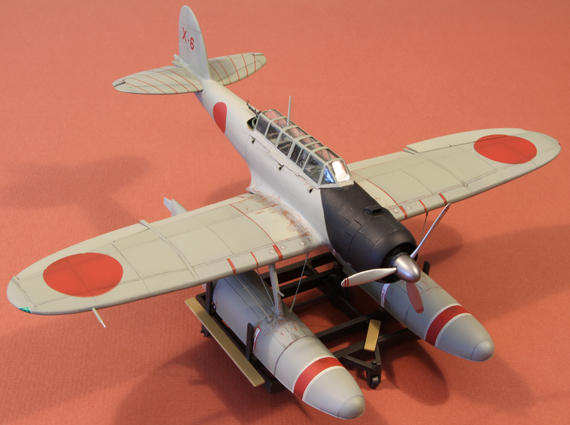
Aircraft: Aichi E13A1 Sui-Tei (Allied code name 'Jake'), "X-6", No. 5 Kokutai, Imperial Japanese Navy, as unloaded from the Kamikawa Maru, Kiska Island, June 1942, pilot unknown.
References: Imperial Japanese Navy Reconnaissance Seaplanes. Famous Airplanes of the World #47, Bunrindo Publishing, July 1994.
Kit: Nichimo #4803 1/48.
Accessories/modifications: Lone Star Models cockpit and fuselage resin set (LSM 0324), Engines and Things resin Mitsubishi Kinsei HA-112 14 cyl. engines (#48-134), propellors replaced with those from Tamiya A6M3 (kit #61025), Lewis gun by Vector (VDS48-016), dolly modification using styrene card, raised rivets and panel lines sanded off and rescribed, second pair of float struts deleted, float rigging made from 0.005" music wire, microtube and white glue, replacement exhausts from drinking straw.
Paint: Tamiya acrylic, Alclad Aluminum II, weathering by oil wash and silver and terra cotta Prismacolor pencil, Testor's Dullcoat from spray can.
Decals: National marks and stencils with paint, 'X-6' with paint and from Hasegawa A6M2N (#09681), custom 'no step here' decal by ILJ.
Issues: Difficult. LSM's resin upgrade a big help. Nichimo's kit is a fairly rough approximation of an E13A1 - e.g., wing shape, cowling and many details questionable, cockpit interior detail absent, beaching dolly does not fit the floats properly, propellor blades are ridiculously broad et c. Missing glass at gunner position. At the end, Dullcoat application brought traces of Sharpie marker lines (originally applied as guides for line scribing) to surface, ruining finish.
A6M2-N Type 2 Sui-Sen ('Rufe')


Aircraft: Nakajima A6M2N, aircraft "O-105", Toko Naval Flying Group, Imperial Japanese Navy, Kiska Island, summer 1942, pilot unknown.
Reference: From the kit.
Kit: Hasegawa #09681 1/48.
Accessories/modifications: Ultracast seat (#48185).
Paint: Tamiya acrylic, Alclad Aluminum II, weathering by oil wash and silver and terra cotta Prismacolor pencils, Testor's Dullcoat from spray can.
Decals: from the kit.
Issues: This aircraft may not have had the dark yellow leading edge stripe (although this is shown in the Hasegawa kit instructions' profiles).
A6M2-N Type 2 Sui-Sen ('Rufe')


Aircraft: Nakajima A6M2N, aircraft "M1-112", 452nd Flying Group, Imperial Japanese Navy, Kiska Island early 1943, pilot unknown.
Reference: From the kit.
Kit: Hasegawa #09681 1/48.
Accessories/modifications: Ultracast seat (#48185).
Paint: Tamiya acrylic, Alclad Aluminum II, weathering by oil wash and silver and terra cotta Prismacolor pencil, Testor's Dullcoat from spray can.
Decals: from the kit.
Issues: This aircraft probably did not have the dark yellow leading edge stripe (although this is shown in the Hasegawa kit instructions' profiles).


Aircraft: Grumman F4F-4 Wildcat of VMO-155, United States Marine Corps, aircraft "F-8", pilot and serial number unknown, aircraft carrier Nassau (CVE 16), battle of Attu, May 11-20, 1943.
Reference: Cloe, J.H. 1992. The Aleutian Warriors: A History of the 11th Air Force & Fleet Air Wing 4. Missoula, Montana: Pictorial Histories Publishing Co. and Anchorage Chapter, Air Force Association.
Kit: Tamiya #61034 1/48.
Accessories/modifications: Ultracast seat (#48029), replacement exhausts made from drinking straw.
Paint: Tamiya acrylic, Alclad Aluminum II, weathering by oil wash and silver Prismacolor pencil, Testor's Dullcoat from spray can.
Decals: From the kit.
Issues: drop tanks probably not used during Attu sorties from Nassau.


Aircraft: Lockheed P-38E 41-2252 'yellow 77' 'Lorna D', Lt. John K. Geddes, 54th Fighter Squadron, United States Army Air Force, battle of Attu, May 23, 1943. n.b. Lieutenant Geddes is shown posed next to his replacement aircraft, P-38G 42-13544 (also displaying the 'Lorna D' nose art), in the period photo above.
"As Lieutenant Geddes pressed his attack, the entire right side of his canopy blew up, apparently struck by a 20 mm shell. Geddes... nursed his barely controllable fighter back to Attu, where he ditched off the coast. Navy Lieutenant Ferguson landed his [OS2U] Kingfisher and pulled the grateful fighter pilot from the water."
Reference: Cloe, J.H. 1992. The Aleutian Warriors: A History of the 11th Air Force & Fleet Air Wing 4. Missoula, Montana: Pictorial Histories Publishing Co. and Anchorage Chapter, Air Force Association.
Kit: Trumpeter #2227, 1/32.
Accessories/modifications: a conversion from Trumpeter's 1/32 P-38L-1-LO kit to a P-38E. Added semicircular intercooler vents in upper wing tips and round intakes at the wing leading edges near the engines (drilled out). Cut, modified (sheet styrene and Milliput), and drilled out kit turbosupercharger to fit P-38 EFG style turbosupercharger shroud. Modified kit turbocharger air supply scoop to P-38 EFG style (shorter, non-laminar flow shape). Added armour shields inboard to turbosupercharger turbines (styrene sheet). Drilled out and placed small tubular air ducts on forward sides of Jerry Rutman resin engine cowlings (drilled out Evergreen rod styrene). Deleted and filled in P-38L leading edge wing lights. Deleted, filled and smoothed over upper wing tip fuel ports. Removed underwing power assist bulges, filled and smoothed out, rescribed all underwing panel lines. Removed gun camera from port drop tank boom, filled and smoothed out, added gun camera opening to nose. Replaced kit (late-type) guns with Quickboost resin guns (#32011). Added scratchbuilt cartridge case chute openings (styrene sheet). Scratch-built long under nose pitot tube (not visible in images). Removed longitudinal frame from rear canopy, sanded and buffed out, Futured, then added two latitudinal scratches. Windscreen frames sanded off, shape sanded to smoother appearance to resemble the curved early-type windscreen, new frames added. Bulletproof glass (from CD case clear styrene), buffed and Futured, inserted under kit windscreen, added fabric instrument pane shroud and modified early type gunsight that is between the windscreen and the armour glass. Six aluminum spars for wing stiffness. Jerry Rutman P-38 EFG 'mk 1' conversion resin (boom radiators and engine cowlings). The John Geddes figure is Master Details U.S. Army Air Force fighter pilot mid-Late WW2 (#32011).
Paint: Tamiya acrylic, Alclad Aluminum II ('Aluminum' and 'Chrome'), weathering by oil wash and silver Prismacolor pencil, Testor's Dullcoat from spray can.
Decals: custom inkjet Lorna "D" decal, custom boom radiator 54th fighter group decals, 77s on nose with paint and masks, national marks with Yellow-wings decals (YW48048) - U.S. National Insignia PT-3 May 1942-June 1943, 'U.S. ARMY' from Barracudacal's P-40 sheet BC32006, Techmod yellow decal serial numbers on tail.
Issues: The Jerry Rutman 'mk 1' resin lower cowlings and boom radiators are not accurately shaped - JR's new resin looks perfect but wasn't available for this build. The modified Revell props are not accurately shaped although they are better than the kit props. The modified kit windscreen only approximates the early type P-38E windscreen (JR also apparently has a complete vacuform P-38EFG canopy, not available for this build).
G4M1 Isshikirikko (Allied code name 'Betty')

Aircraft: Mitsubishi Isshikirikko Type 11 G4M1 (Allied code name 'Betty'), aircraft "W2-373", pilot unknown, 752 Kokutai, Imperial Japanese Navy, based at Paramushiro Island, Kurile Islands, battle of Attu, May 23, 1943 (photo by Ted Spencer, background art by Mark Styling).
Reference: Osamu Tagaya "Mitsubishi Type 1 Rikko 'Betty' Units of World War 2", Osprey publications (Combat aircraft #22).
Kit: Tamiya #61049 1/48.
Accessories/modifications: None.
Paint: Tamiya acrylic, Alclad Aluminum II, weathering by oil wash and silver and terra cotta Prismacolor pencils, Testor's Dullcoat from spray can.
Decals: All markings except tail code done with paint, tail code with borrowed elements from Hasagawa A6M2N kit (#09681).
Issues: Kit is excellent. Unknown whether this particular aircraft participated in the May 23, 1943 attack on Attu Island. Wear and tear on this aircraft also unknown as no photographs from May 1943 are available - consequently model was done with very clean appearance (except for exhaust staining) and intact paint.
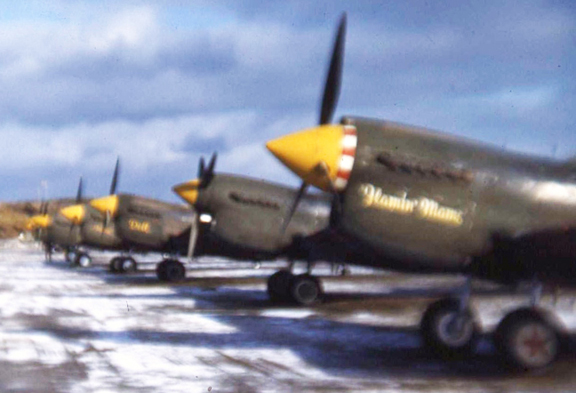

Aircraft: Curtiss P-40K-1-CU Warhawk 42-45949, 343rd Fighter Group, 18th fighter squadron, US Army Air Force, Amchitka Island, autumn 1943, pilot Lt. Paul G. Budesa.
References: from the 1943 photographs provided by Karl Budesa (above and below). This aircraft would have had the factory applied blue roundel with white star (1942), modified in spring 1943 to include white bars and the red surround, and finally the blue surround added autumn 1943 - leaving the blue roundel quite faded compared to the dark blue surround as in the image of 'Dell', above.
Kit: Hasegawa #08079 1/32.
Accessories/modifications: Eduard seatbelts (here), gunsight from music wire.
Paint: Tamiya acrylic, Alclad Aluminum II, weathering by oil wash and silver Prismacolor pencil, Testor's Dullcoat from spray can.
Decals: National marks, white bars and underwing 'U.S. ARMY' lettering with Tamiya paint and AdAstra masks. Nose art custom decal by ILJ (here), Techmod US yellow serial numbers (48807).
Issues: I think 42-45949 was a commonwealth scheme aircraft (Dupont dark earth and medium green), as suggested by the patches of the 'dark [sic] earth' on the tailplane and top of engine cowling (images below and above). Alternatively, substitute parts (e.g., the engine cowling top, rudder and trim tab) could have been added to repair a damaged uniform olive drab aircraft (e.g., 42-45943, here) with faded paint overall, or the aircraft could have been overall very faded olive drab with fresh dark olive drab and medium green patches. The unusual paint patches on the rudder suggest it was a replacement item, with an overpaint to correct the aircraft's serial number. Photos also suggest the sides of engine cowling were painted over with fresh matt olive drab before application of the 'Flamin' Mame' logo nose art, as on other aircraft in the group. Several of the reference photos show a contrast between the matt cowling and the glossy remainder of the aircraft (note the light tan/sand shade of 'earth' - colour selected for the model - photos of Aleutian P-40s show this). Aleutian P-40s had treaded tires (not available yet as a resin aftermarket item).
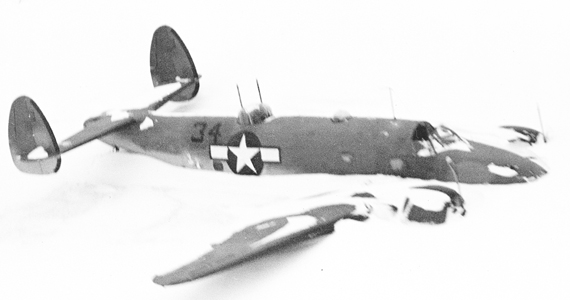
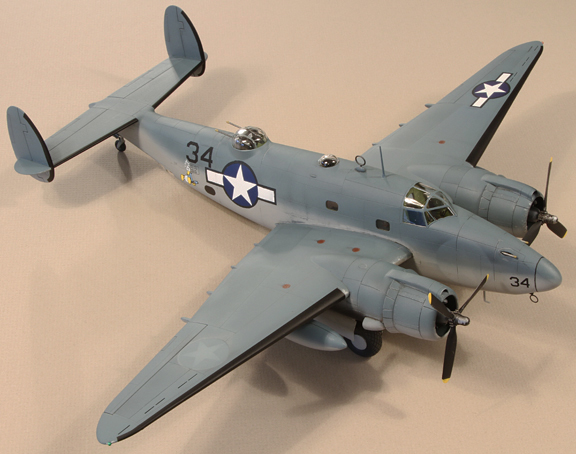
Aircraft: PV-1 ‘34', Bureau number 3334, of VB13, belly-landed at Agattu Island after becoming lost in bad weather while returning from a reconnaissance mission from Attu (all crew survived), December 30, 1943, pilot V. C. Austin.
References: the above photo.
Kit: Revell #85-5531 1/48.
Accessories/modifications: Ultracast resin wheels and tires (48233), Ultracast corrected resin exhausts (48234), Vector corrected resin propellors (VDS48-055), Vector resin corrected cowlings (VDS48-056), DMold corrected fuselage (DM48028). Eduard seatbelts (48365). Starboard fuselage window repositioned below national mark (see reference photo above). Kit tailwheel (very weak) reinforced with brass rod.
Paint: Tamiya acrylic, Alclad Aluminum II, weathering by oil wash and silver Prismacolor pencil, Testor's Dullcoat from spray can.
Decals: kit decals except AeroMaster black 45º numbers (48802), fuselage donald duck cartoon (Zotz ZTZ48009) fuselage national marks (Yellow Wings YW48048 - US National insignia PT-3 May 1942-June 1943 modified with pain) and 'ghost' markings (Yellow Wings YW48048).
Issues: Kit has some shape issues (lower forward fuselage and propellors that require replacement after-market parts - expensive!).
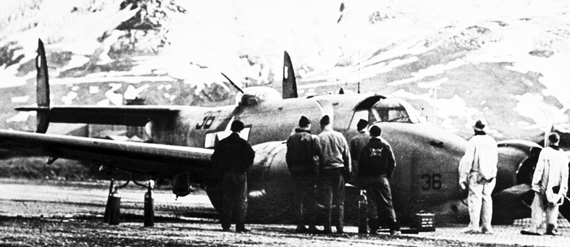

Aircraft: PV-1 ‘36’ of VB139, belly-landed at Attu after being damaged during a mission to the Kurile Islands, May 18, 1944, pilot Quentin Norem. Co-pilot Clifford Tambs was killed during the engagement.
References: the above photo.
Kit: Revell #85-5531 1/48.
Accessories/modifications: Ultracast resin wheels and tires (48232), Ultracast corrected resin exhausts (48234), Vector corrected resin propellors (VDS48-055), Vector resin corrected cowlings (VDS48-056), DMold corrected fuselage (DM48028). Eduard seatbelts (48365). Kit tailwheel (very weak) reinforced with brass rod.
Paint: Tamiya acrylic, Alclad Aluminum II, weathering by oil wash and silver Prismacolor pencil, Testor's Dullcoat from spray can.
Decals: From the kit except AeroMaster black 45º numbers (48802).
Issues: Kit has some shape issues (lower forward fuselage and propellors that require replacement after-market parts - expensive!).


Aircraft: North American B-25J-10-NC Mitchell, 43-36128, First Lt. Douglas E. Banker, 77th Bomb Squadron, United States Air Force, Alexai Point, Attu Island, 1944
"B-25J-10-NC Mitchell 43-36128 of 11th Air Force, 28th Composite Group, 77th Bomb Squadron, based at Attu, lost on December 29, 1944 during a fighter decoy sweep of Suribachi Airfield on Paramushiru Island, Kurile Islands. Lt. Banker radioed Lt. Leonard Kupersmith that he was executing a 180-degree turn, but was never heard from again."
Reference: http://www.worldwar2database.com/html/b25j_336128.htm
Kit: Revell #85-5512 1/48
Accessories/modifications: True Details tires, Scale Aircraft Conversions landing gear (nose). Large bow RDF antenna fabricated from stainless steel wire.
Paint: Alclad Aluminum II (four shades),Tamiya acrylic, weathering by oil wash and silver Prismacolor pencil.
Decals: from the kit, Techmod numbers.


Aircraft: PV-2 '24' of VPB 139, U.S. Navy, Casco airstrip, Attu Island, Aleutian Islands, Alaska March, 1945. Pilot: Lt. Alfred "Fritz" Daniel.
References: the above photos, and Ginter, S. 2010. Lockheed Vega PV-1 Ventura and PV-2 Harpoon. Naval Fighters #86. Ginter Publications, Simi, California ISBN# 0-942612-86-8, and Scrivner, C.L. and Scarborough, W.E. 1981. PV-1 Ventura in Action. Squadron/Signal Publications, Carrollton, Texas ISBN# 0-89747-118-0.
Kit: Special Hobby #72093 1/72.
Accessories/modifications: Seatbelts added (masking tape), 5" HVR rockets were borrowed from a 1/72 Tamiya Corsair kit (60752), rocket ignition wires made of fine copper wire added, radio antenna mast fabricated from strene card substituted for the crude kit part, large bow RDF antenna from spares box. Top turret sanded down 2 mm to a lower profile (correction). Fixed forward guns replaced with brass rod. Turret and ventral guns will be replaced with Quickboost resin eventually. Eduard canopy masks VERY helpful, recommended.
Paint: Tamiya acrylic, Alclad Aluminum II, weathering by oil wash and silver Prismacolor pencil, Testor's Dullcoat from spray can.
Decals: From the kit except all national marks with Tamiya acrylic paint and AdAstra masks.
Issues: This is an excellent limited run kit with very fine surface detail, and is the best option for representing this obscure aircraft. The wings were attaced to the fuselage halves before these were joined, with reinforcements made from epoxy putty plugs in the wing roots and brass rods extending through the butt joint at the fuselage sides into the plugs, for strength, and to get the correct and symmetrical dihedral. The guns need to be replaced with scratchbuilt or aftermarket parts. What colour was the nose radome? (yellow?) Buy your own Harpoon (here).
A6M2-N Type 2 Sui-Sen ('Rufe') Tamiya&MDC 1/32


Aircraft: Nakajima A6M2N, aircraft "R-106", Toko Naval Flying Group, Imperial Japanese Navy, Kiska Island, summer 1942, pilot unknown. Depicted very clean and new, as if freshly unloaded from Kimikawa Maru at Kiska Harbour, July 1942.
Reference: From the kit.
Kit: Tamiya #60317 1/32.
Accessories/modifications: Model Design Construction 'A6M2-N RUFE Zero Float Plane Conversion' (CV32039), CMK resin seat for Tamiya 1/32 A6M2 kit (Q32116), antenna cable from Uschi Rigging Bobbin - standard (USH4005).
Paint: Tamiya acrylic, Alclad Aluminum II, weathering by oil wash and silver and terra cotta Prismacolor pencils, Testor's Dullcoat from spray can.
Decals: Tail code from the kit decals, modified with a scalpel blade. Otherwise with paint/masks.
Issues: None. Straightforward build.
"Fair dealing is the right, within limits, to reproduce a substantial amount of a copyrighted work without permission from, or payment to, the copyright owner."
![]()
![]()
Last updated: August 14,
2019 ![]()